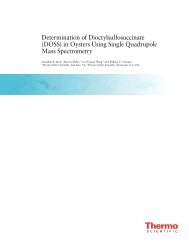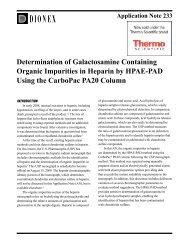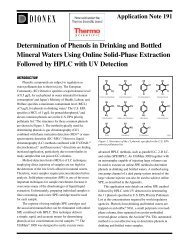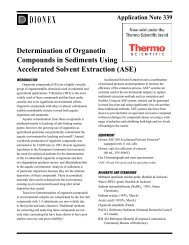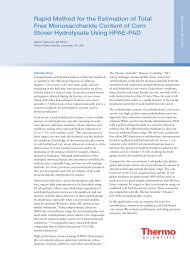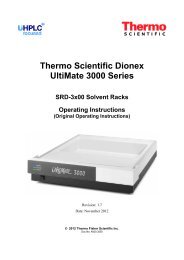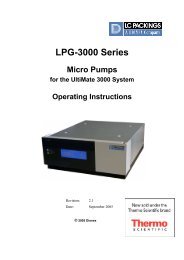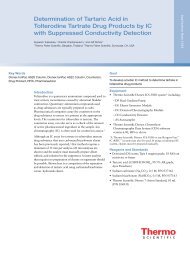Rapid Analysis of Aminothiols by UHPLC with Boron ... - Dionex
Rapid Analysis of Aminothiols by UHPLC with Boron ... - Dionex
Rapid Analysis of Aminothiols by UHPLC with Boron ... - Dionex
Create successful ePaper yourself
Turn your PDF publications into a flip-book with our unique Google optimized e-Paper software.
e and Thioether <strong>Analysis</strong><br />
fic Accucore RP-MS column<br />
50 mm<br />
ropropionic acid, 0.02% ammonium<br />
acetonitrile, water<br />
; 4 µL samples<br />
fic <strong>Dionex</strong> model 6041RS ultra<br />
nalytical Cell <strong>with</strong> BDD electrode at<br />
blood + 200 µL 0.4 N PCA, mix and<br />
tes at 13,000 RPM. The clear<br />
s transferred into an autosampler vial<br />
he autosampler at 10 °C.<br />
iMate 3000 Electrochemical detector<br />
tical Cell <strong>with</strong> BDD electrode<br />
oViper fingertight capillaries<br />
3000 <strong>UHPLC</strong> system consists <strong>of</strong>:<br />
utosampler<br />
mn compartment<br />
ata System s<strong>of</strong>tware<br />
is is that the HPLC system must be<br />
n order to achieve optimal sensitivity<br />
m shown above in Figure 2A uses<br />
duce the influence <strong>of</strong> metal that can<br />
t the electrochemical cell. The recent<br />
ables multiple electrodes to be<br />
Use <strong>of</strong> the 6041RS amperometric cell (Figure 2B) provides the unique<br />
electrochemical capabilities <strong>of</strong> the boron-doped diamond which enables the<br />
oxidation <strong>of</strong> organic compounds using higher electrode potentials than other<br />
working electrode materials. This platform provides both chromatographic and<br />
voltammetric resolution <strong>of</strong> compounds. The nanoViper (Figure 2C) fingertight<br />
fittings were employed to cope <strong>with</strong> the higher pressures due to smaller column<br />
particles. These fingertight, virtually zero-dead-volume (ZDV) capillaries can<br />
operate at pressures up to 14,500 psi and are much safer to use than PEEK<br />
tubing which can slip when using elevated pressures. They are made <strong>of</strong> PeekSil<br />
tubing and are available in small internal dimensions to minimize chromatographic<br />
band spreading. Capillaries used on this system were 150 micron ID for all<br />
connections made prior to the autosampler valve and 100 micron ID for those made<br />
after the injector valve.<br />
FIGURE 3. Overlay <strong>of</strong> analytical standards ranging from 1–20 µg/mL<br />
3.0<br />
µA<br />
2.8<br />
2.6<br />
2.4<br />
2.2<br />
2.0<br />
1.8<br />
1.6<br />
1.4<br />
1.2<br />
1.0<br />
0.8<br />
0.6<br />
0.4<br />
0.2<br />
CysGly<br />
GSH<br />
Methionine<br />
HCYS<br />
-0.0<br />
min<br />
0.0 0.2 0.4 0.6 0.8 1.0 1.2 1.4 1.6 1.8 2.0 2.2 2.4 2.6 2.8 3.0 3.2 3.4 3.6 3.8 4.0 4.2 4.4 4.6 4.8 5.0<br />
The direct electrochemical detection <strong>of</strong> aminothiol compounds only using a borondoped<br />
diamond electrochemical cell has been previously described. 1 The applied<br />
potential used for this study (+1600 mV) was sufficient to oxidize both thiol and<br />
disulfide analytes. Advantages <strong>of</strong> this approach include a stable electrode surface<br />
and method simplicity since no sample derivatization is required. After each<br />
analysis the electrode surface was regenerated <strong>by</strong> a 10 second clean cell pulse at<br />
+1900 mV. After a 1.5 minute re-equilibration at +1600 mV the electrode was once<br />
again stable and could be used for the analysis <strong>of</strong> the next sample. In the current<br />
method, the whole blood sample was added to the perchloric acid media, mixed<br />
and then centrifuged. The clear supernatant was then transferred into an<br />
autosampler vial and placed on the autosampler at 10 C. This approach enabled<br />
rapid sample processing thus minimizing issues related to the instability <strong>of</strong> the<br />
thiols. <strong>Rapid</strong> <strong>UHPLC</strong> analysis as shown in Figure 3 enables processing <strong>of</strong> these<br />
samples <strong>with</strong>in three minutes before any major chemical transformations take<br />
place.<br />
For biological studies, the determination <strong>of</strong> aminothiol content should include<br />
compounds such as GSH, GSSG, methionine, and homocysteine. Figure 3<br />
illustrates the overlay <strong>of</strong> calibration standards for these compounds ranging from<br />
1–20 µg/mL. Peak resolution and retention time uniformity were both excellent.<br />
The column used for this method was the Accucore RP-MS 2.6 micron solid-core<br />
material which provides fast, high resolution separations but <strong>with</strong> lower system<br />
pressures. When operated at 0.5 mL/min at 50.0 C the backpressure was less<br />
than 300 bar <strong>with</strong> the last compound (GSSG) eluting under 2.8 minutes as shown<br />
in Figure 3.<br />
The calibration curves for aminothiol standards are shown in Figure 4. Good<br />
linearity <strong>of</strong> response to different concentrations was obtained <strong>with</strong> correlation<br />
coefficients ranging from R 2 = 0.989–1.00 for the five compounds evaluated<br />
(Table 1) over the range <strong>of</strong> 1–20 µg/mL. The percent relative standard deviation<br />
(%RSD) for the calibration curves (five concentrations in triplicate) is also shown<br />
in Table 1. The RSD values ranged from 1.2% to 8.9%, indicating that the BDD<br />
electrode provided good stability during this study.<br />
GSSG<br />
20 ug/mL<br />
10 ug/mL<br />
5 ug/mL<br />
2 ug/mL<br />
1 ug/mL<br />
Response (µA)<br />
0.12<br />
0.10<br />
0.08<br />
0.06<br />
0.04<br />
0.02<br />
0.00<br />
-0.02<br />
FIGURE 4. Calibration cu<br />
1.6<br />
1.4<br />
1.2<br />
1<br />
0.8<br />
0.6<br />
0.4<br />
0.2<br />
0<br />
0 5<br />
CysGly<br />
Table 1. Regression data<br />
Poin<br />
Peak #<br />
CysGly 15<br />
GSH 15<br />
Meth 15<br />
HCYS 15<br />
GSSG 15<br />
Enhanced peak shape (na<br />
<strong>of</strong> the 6041RS cell <strong>with</strong> a B<br />
volume <strong>of</strong> only 50 nL contr<br />
the noise <strong>of</strong> the electroche<br />
illustrates that amounts les<br />
determined <strong>by</strong> this method<br />
shown in Table 2 and rang<br />
ratio <strong>of</strong> 5 are also shown in<br />
5 is also shown in this tabl<br />
LOD for GSSG is 175 pg o<br />
FIGURE 5. Sensitivity <strong>of</strong><br />
0.15<br />
µA<br />
CysGly<br />
GSH<br />
0.0 0.5 1.0 1.5<br />
Table 2. Signal-to-noise r<br />
Compound CysG<br />
S/N Ratio 37<br />
LOD (pg, S/N <strong>of</strong> 5) 54<br />
4 <strong>Rapid</strong> <strong>Analysis</strong> <strong>of</strong> <strong>Aminothiols</strong> <strong>by</strong> <strong>UHPLC</strong> <strong>with</strong> <strong>Boron</strong>-Doped Diamond Electrochemical Detection




